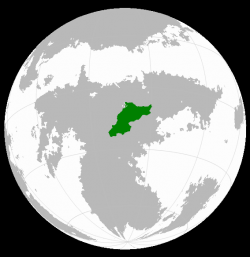Difference between revisions of "Archive:Tabiqa"
| Line 125: | Line 125: | ||
==History== | ==History== | ||
Tabiqa has been inhabited by varying peoples and under different regimes and empires for hundreds of thousands of years. Its location in the Baredina desert alongside some of the only major waterways that cross the expanse has given it great strategic trading power throughout history. The modern nation is a successor state of the [[ | Main article: [[Adzamasi Empire]] | ||
Tabiqa has been inhabited by varying peoples and under different regimes and empires for hundreds of thousands of years. Its location in the Baredina desert alongside some of the only major waterways that cross the expanse has given it great strategic trading power throughout history. The modern nation is a successor state of the [[Adzamasi Empire]] (Tahid Aadsamiyaad), which collapsed in the 900s to the rising Penaxxi Empire, and later the Kauzian Empire. Modern state borders were established in the mid 1800s, which then solidified into one nation near the end of the century. | |||
==Geography== | ==Geography== | ||
Revision as of 10:28, 29 February 2016
| Republic of Tabiqa Duqittuuria Tabiqa |
||||
|---|---|---|---|---|
|
||||
| Capital and | Mehyaran | |||
| Official languages | Adzamasi | |||
| Recognised regional languages | Dzimraic, Kavahiri, Osuri | |||
| Ethnic groups | 46.1% Adzamasiin 18.26% Osureko |
|||
| Demonym | Tabiqan Tabiqiri (pl) |
|||
| Government | ||||
| - | King | Tolyar Okmaruud bal Henuut | ||
| - | President | Keyvat Nahdein bol Accekoon | ||
| Area | ||||
| - | 2,011,576 km2 776,674 sq mi |
|||
| Population | ||||
| - | census | 36,282,180 | ||
| - | Density | 13/km2 33.7/sq mi |
||
| Currency | Mahri (TBM) | |||
| Drives on the | right | |||
| ISO 3166 code | TBQ | |||
| Internet TLD | .tab | |||
Tabiqa (IPA: /tæbɪkə/, Adzamasi: Tabiqa, IPA: /tɐbɪqɐ/), officially the Republic of Tabiqa, is a landlocked country located in central north Baredina. A mostly desert nation, its population is concentrated in the cooler and better-irrigated areas around its mountains and rivers, and many of its inhabitants are nomadic. It is bordered by Barradiwa, Ebo Nganagam, Algador, Penaxxi, Yutte Basi, and Izovangia.
Etymology
History
Main article: Adzamasi Empire
Tabiqa has been inhabited by varying peoples and under different regimes and empires for hundreds of thousands of years. Its location in the Baredina desert alongside some of the only major waterways that cross the expanse has given it great strategic trading power throughout history. The modern nation is a successor state of the Adzamasi Empire (Tahid Aadsamiyaad), which collapsed in the 900s to the rising Penaxxi Empire, and later the Kauzian Empire. Modern state borders were established in the mid 1800s, which then solidified into one nation near the end of the century.
Geography
Tabiqa is bordered by the Tabiq river in the west, the ??? river to the north, and the Püzimmese mountains in the east. It is a landlocked country, but has access to the ??? lakes in the northwest.
Geology
Most of Tabiqa is fairly high above sea level, with a few mountains in the east. The rest of the country is mainly situated on a broad desert marked only by sand dunes, with small valleys cradling the rivers to the north and western borders.
Climate
Tabiqa is mainly situated in the Baredina desert and, as such, is a very hot, dry, and arid country. Some parts of the country experience a short wet season, but most of it can go for an entire year without rain. There are fertile river valleys surrounding the major waterways, and some arable land near the lakes in the north-west an the eastern mountains, but most of the country is only fit for habitation by nomadic peoples.
In the northeast there is a fertile subtropical climate, which is responsible for most agriculture in Tabiqa. Deforestation to increase space for farmland has lead to desertification, first noticed in the 1920s, and replanting efforts since 1960 have begun to slow this process.
Biodiversity
Politics
Government
Tabiqa's head of state is a monarch, who held total power until the end of the Great Ekuosian War. The monarch is now generally a figurehead, although some powers are still vested with the throne. A president elect serves as the functional head of a government, alongside a small congress.
Administrative divisions
Foreign relations
Military
Economy
Transport
Energy
Science and technology
Tourism
Demographics
Ethnic groups
There are more than eighty recognized ethnic groups among the Tabiqan population, at least sixteen of which are considered native to the region. The most populace is, by far, Adzamasi, representing over 32% of the population.
Gender
Tabiqa legally recognizes four different genders, and some parts of the population culturally recognize five or more genders as well.
Urbanisation
Language
The official language of Tabiqa is Adzamasi, which is spoken natively by approximately 32% of the population, and fluently by a further 22%, for a total of 54% fluency in the nation.
Education
Healthcare
Religion
A very large proportion of the population follows the Adzamasiin religion.

